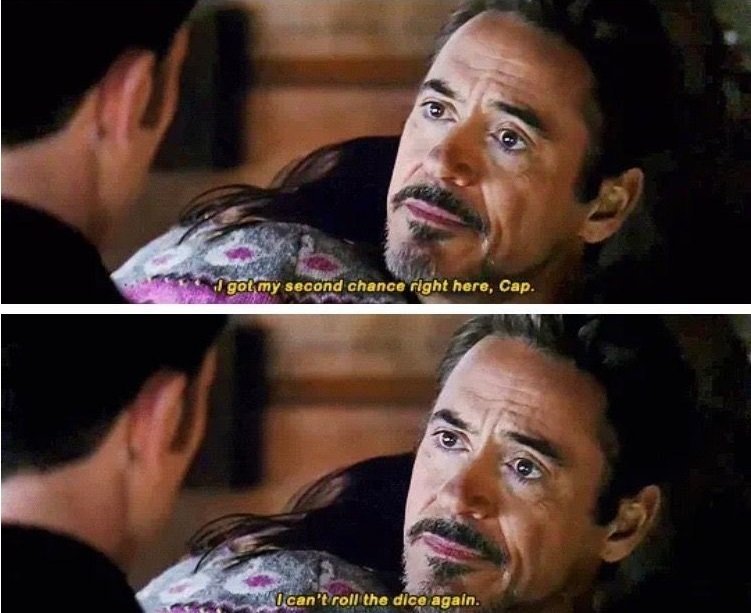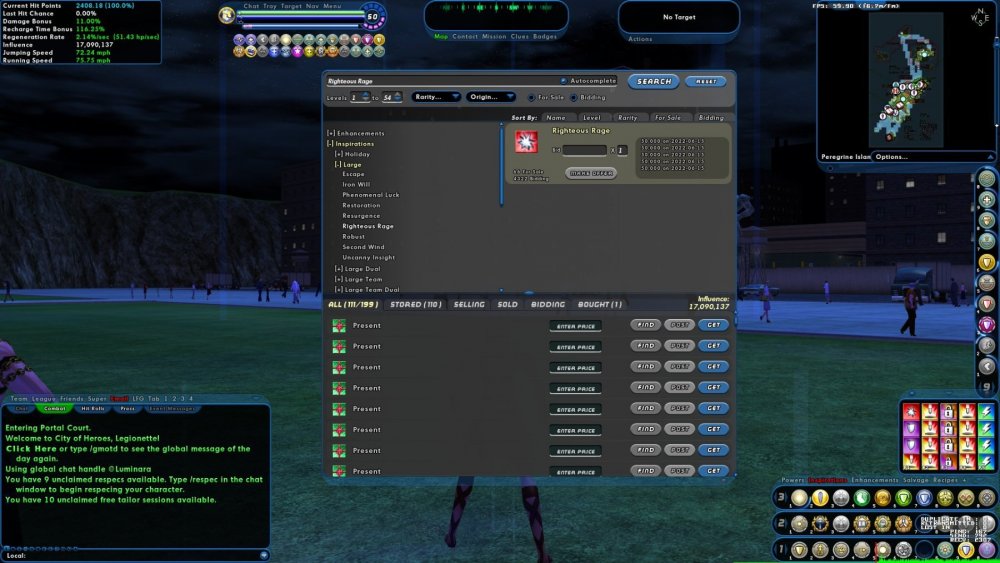The Beta Account Center is temporarily unavailable
×
-
Posts
5452 -
Joined
-
Last visited
-
Days Won
118
Content Type
Profiles
Forums
Events
Store
Articles
Patch Notes
Everything posted by Luminara
-
I don't power-level (i do use the 2XP option), I don't farm, I don't use the Architect stuff for anything... and I don't care if anyone else does, or doesn't, do any of those things. I do my things my way, others do their things their ways and I don't make it my business to tell them their business. To date, no-one's made it their business to tell me my business, either, so the world spins on. The sole objection I have to farming is the clutter it causes in various archetype forums (it's difficult to find a good discussion when the first ten pages are crammed with people begging for farming builds). And I deal with that by ignoring the archetype forums entirely unless a specific topic catches my eye. Farm, don't farm, market, don't market, PL, don't PL, AE XP, don't AE XP, whatever.
-
-
If that were true, this issue would've occurred every summer, six months after winter packs sold for 10,000,000 and mass purchasers were opening them to cash in. It would've been especially notable last summer, when the player population was peaking due to the coronavirus lockdown and mass pack purchasers were going on opening sprees to recoup their investments (which were sizeable, as it was rumored to be the last 10m winter pack sale (which it was). But we're only now seeing this happen, so the evidence suggests that there's another cause. I'll also re-iterate my previous observation, for those still having trouble: remove something from the AH when this happens. Doesn't seem to matter what it is, doesn't even have to be something you just stored or listed, just pull something out of your AH inventory. I've opened about 60 packs to test, and every time claim problem crops up, pulling something out of my AH inventory jogs the machine into motion again.
-
I tried WoC when I was leveling my Dark/Martial and was really disappointed in it. In the last update, they enabled Domination for it and I gave it a second look, and I have to say I'm much happier with it now. Possess isn't in my build, but with the Coercive Persuasion proc and Domination, I can skip using Fearsome Stare on every spawn (how i hit the soft cap to all damage types with this character) and just run in and start punching, kicking and throwing. It's not Link Minds good, but it's better than it was. But that assessment is from the perspective of strictly melee combat, ranged characters probably won't get enough value out of it to warrant the toggle cost. And this was a power I wanted for thematic fulfillment (this character was inspired by DC's Huntress, and a PBAoE confuse adds that element of enemies panicking and wildly swinging/shooting), so for this character, I'm biased in favor of the power.
-
-
Overhaul the entire animation system to allow mobile combat (having to stand still, or joust, is lame), add terrain deformation so we could do things like knock holes in walls, redesign the character mesh and morph systems so we could have moving mouths/eyes/fingers/toes and realistic knockback effects (not ragdoll post-KB/KD/KU, rather something like an enemy folding in half at the midriff when kicked in the stomach, flying backward, impacting a surface and splaying out on impact), refine the character creator/editor color options, and make all animations customizable in respect to whether or not they're even visible (NO MORE TOGGLE SPAM).
-
Almost all of my characters use it. I recognize that it's not as fast as Super Speed, but it's fast enough, and it doesn't jump as high as Super Jump, but it jumps high enough. It's not the best at either movement, but it's good enough at both. And I'm not competing in an imaginary race to determine who's digital penis is girthier, so if someone else is reaching a mission door 8.62 seconds sooner, or sneaking to the last room on a mission map 5 seconds faster, with another travel power, it doesn't mean anything to me. As far as I'm concerned, Infiltration is the bee's knees.
-
I blame you, too. Motion seconded and passed, everything is @Ukase's fault now.
-
Quitting anything isn't the worst anything that anyone can do. Sometimes, it's just not gelling, and there are no magical success fairies who will swoop in and sprinkle win dust on us when it seems that all hope is lost. If a team isn't working, leave. If the *F isn't moving, leave. If the SG isn't what you need, leave. Adamantly refusing to let the suffering end simply because one has imposed an imaginary social contract on oneself is pointless. Expecting that everyone else will continue to futilely beat their heads against the wall is delusional. And outright telling others that the worst thing they can do is give up, is manipulative, because you're pinning your expectations on them, trying to force them to stay so you can succeed. People don't always work well together. Bad days, distractions, lack of familiarity with content or powers, poor communication, there are any number of reasons groups of players can't or don't mesh, or even coalesce long enough to function as a unit. Sometimes it's your fault, and the best thing you can do is walk away rather than continue to drag everyone else down with you. As for the worst thing someone can do, I see a lot of personal grievances, not much in the way of actual bad. So I'm going to say that the worst thing anyone can do is forget that all of this didn't exist just a few years ago. When Co* was gone, it was gone, and a lot of us here spent years trying to fill the gaping hole it left behind, unsuccessfully. We have it all back now. We lost some years, we lost some friends, but we still have this. Failing to remember that, to keep in mind just how precious and rare this is and how much it means, taking it for granted, that's the worst thing any of us can do. No petty annoyance will ever come close to being as bad as no longer cherishing what we've recovered.
-
What I encountered was an odd lag. Not client lag, not increased latency due to high network traffic, but lag in how the mission proceeds. After freeing the police captain, Silent Blade is supposed to spawn and ambush the player character. This morning, it took almost two minutes for her to spawn. Upon defeating Silent Blade (she changes to friendly at ~25% HP), you engage in a short conversation with her, and Your Mysterious Double is supposed to spawn with a Malta ambush when you click the final dialogue option. Again, it took almost two minutes for this to occur. Both of those spawns are supposed to be instantaneous. This is likely related to the other recent server issues. This obviously isn't something that can be fixed by itself, if it is connected to those other server problems, it may provide another avenue of exploration toward resolution.
-
Tomorrow, the Cosmic Power of @Telephone. Assassination plot? 🔪
-
If I don't open them, it's always Christmas. 🙂
-
*drops the needle* *drops the mic* *drops it like it's hot* *drops trousers* Oh dear...
-
Neither the standard nor the superior version are flagged to ignore enemy level.
-
I'm waiting for someone to market the manipulation. FLIP THE NARRATIVE! FIGHT THE POWER! CHEW SOUP!
-
Just encountered this problem today, and noted a correlation. I've been working on my TA/Dark's build this week and used up the the last granted respec this morning, but a bit more prodding and poking gave me a few more improvements, so I opened my last 23 Wint-O-Green packs in hope of a respec dropping. None did, so I collected the enhancements, posted them all on the market, and tried to claim an inspiration... and that's when it nailed me. Kept giving me "Request pending" messages, like everyone else has reported. I entered my base, same thing. Logged out, logged back in and tried again, and nothing. Gave up and bought a respec recipe, crafted, used, fiddled with enhancements until I ran out of merits, Empyreans and converters, and tried claiming converters, and still, "Request pending". Tried claiming merits, "Request pending". At this point, it's been about 40 minutes and I'm really starting to become disgruntled. I think we all prefer me gruntled (yes, that's a word). So I'm about to log out and switch to another character to transfer some hero merits or Empyreans, and I decide to check the market to see if any of the Lifesavers sold before I switch. I click the "Get all" button... And the last thing I tried to claim, 25 merits, pops into my salvage inventory. It happened simultaneously with claiming inf* from the market. And I mean simultaneously. The instant I pressed "Get all", the merit vendor window lit up like a Christmas tree. Gruntled (sounds so dirty, doesn't it), I claim another 25 merits, buy some converters and resume the immensely important task of rejiggering enhancements for my character. Before I run back to my base for more enhancements, I figure I should grab those inspirations and get them in the market while I have the window open. I claim six inspirations, move them to the market, and scroll down the list for the next inspiration to claim. I click... and here we go again. "Request pending". I do my best impression of Samuel L. Jackson when this happens. You'd love it, it's really good. And then it occurs to me, if claiming that inf* from the enhancement sales kicked the claim code into gear again, maybe removing the inspirations from the market (which i had not posted for sale yet) would do the same. So I do exactly that, pull all six of the inspirations back into my tray. A scant few seconds later, the last two items I tried to claim suddenly come through. Well, one did, the second failed because my inspiration tray was full. I run back to my base immediately, park Parthenia in front of an inspiration storage unit and start claiming and dumping, and the only hitch I encountered was a "Hol-up, dawg, y'all's clickin' too fast" warning. You know, like the market does when you try to claim 50 sales at once. So, based on that quick, dirty and entirely unplanned test, placing items in the market, even if they're not being put up for sale, seems to be responsible for stalling the claim process. I'm going to buy an ice cream bar now.
-
Removing lower-priced purples from circulation leaves only higher-priced purples. Replacing those lower-priced purples with higher-priced purples doesn't reduce the average price of purples, it increases the average price. The market is thus manipulated to increase the price of purples. This is the most fundamental principle of flipping. Raise the average price by removing or restricting the availability of lower-priced goods. The intent may be different (and i was not implying that @Snarky was doing this maliciously, so if that was what it seemed to be, i apologize (but i don't apologize for pointing out the hypocrisy of complaining about rising prices when one admits to raising prices)), the motivation may be different, the quantity may be different, but the result is the same because the activity is the same. Whether it's purples or uncommon salvage, flipping increases prices as a direct result of the activity of buying low and selling high, and flipping is market manipulation. The impact of flipping "a few" enhancements may be shorter-term than mass purchasing of an entire category of salvage and flipping everything at 5-10x the previous price, but even that's not guaranteed. There is no control over player behavior.
-
You're manipulating the market. It doesn't matter which section, it doesn't matter what price range, it doesn't matter whether you do it for 5 minutes a week or 5 hours every day, you are manipulating the market, and claiming "I only do it a little, it's everyone else who's bad for doing it!" only makes you sound hypocritical, entitled and whiny. I'm always delighted to receive advice on educational avenues and criticism of my intelligence from people who display spelling and punctuation deficiencies.
-
So it's fine if you're the manipulator, if you're the one driving prices up on something, if you can assuage your conscience with contrived justification, but other people doing it is bad. Oh, yeah, this thread just became a lot more fun. Where's my napalm...
-
Common salvage was more expensive than that on the original servers. 10k wouldn't have been enough for a lay-away payment on a Luck Charm. Perspective, ladies and gents. Even if the price of uncommon salvage stays where it is permanently, it's still laughably low in comparison to what it could be, very affordable and far, far below the seeded price.


.thumb.gif.bf057c72112faaa7a493e6730968d83e.gif)






